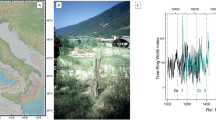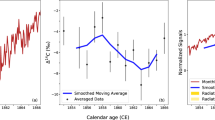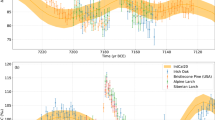Abstract
The Sun provides the principal energy input into the Earth system and solar variability represents a significant external climate forcing. Although observations of solar activity (sunspots) cover only the last about 400 years, radionuclides produced by cosmic rays and stored in tree rings or ice cores serve as proxies for solar activity extending back thousands of years. However, the presence of weather-induced noise or low temporal resolution of long, precisely dated records hampers cosmogenic nuclide-based studies of short-term solar variability such as the 11-yr Schwabe cycle. Here we present a continuous, annually resolved atmospheric 14C concentration (fractionation-corrected ratio of 14CO2 to CO2) record reconstructed from absolutely dated tree rings covering nearly all of the last millennium (ad 969–1933). The high-resolution and precision 14C record reveals the presence of the Schwabe cycle over the entire time range. The record confirms the ad 993 solar energetic particle event and reveals two new candidates (ad 1052 and ad 1279), indicating that strong solar events that might be harmful to modern electronic systems probably occur more frequently than previously thought. In addition to showing decadal-scale solar variability over the last millennium, the high-temporal-resolution record of atmospheric radiocarbon also provides a useful benchmark for making radiocarbon dating more accurate over this interval.
This is a preview of subscription content, access via your institution
Access options
Access Nature and 54 other Nature Portfolio journals
Get Nature+, our best-value online-access subscription
$29.99 / 30 days
cancel any time
Subscribe to this journal
Receive 12 print issues and online access
$259.00 per year
only $21.58 per issue
Buy this article
- Purchase on Springer Link
- Instant access to full article PDF
Prices may be subject to local taxes which are calculated during checkout




Similar content being viewed by others
Data availability
The excel data that support the findings of this study are available in PANGEA at https://doi.org/10.1594/PANGAEA.921808.Source data are provided with this paper.
References
Lal, D. & Peters, B. in Kosmische Strahlung II: Handbuch der Physik 551–612 (Springer, 1967).
Herbst, K., Muscheler, R. & Heber, B. The new local interstellar spectra and their influence on the production rates of the cosmogenic radionuclides 10Be and 14C. J. Geophys. Res. Space Phys. 122, 23–34 (2017).
Kovaltsov, G. A., Mishev, A. & Usoskin, I. G. A new model of cosmogenic production of radiocarbon 14C in the atmosphere. Earth Planet. Sci. Lett. 337, 114–120 (2012).
Snowball, I. & Muscheler, R. Palaeomagnetic intensity data: an Achilles heel of solar activity reconstructions. Holocene 17, 851–859 (2007).
Bard, E., Raisbeck, G., Yiou, F. & Jouzel, J. Solar irradiance during the last 1200 years based on cosmogenic nuclides. Tellus B 52, 985–992 (2000).
Muscheler, R. et al. Solar activity during the last 1000 yr inferred from radionuclide records. Quat. Sci. Rev. 26, 82–97 (2007).
Usoskin, I. G. A history of solar activity over millennia. Living Rev. Sol. Phys. 10, 1 (2013).
Beer, J., Vonmoos, M. & Muscheler, R. Solar variability over the past several millennia. Space Sci. Rev. 125, 67–79 (2006).
Steinhilber, F., Beer, J. & Frohlich, C. Total solar irradiance during the Holocene. Geophys. Res. Lett. 36, L19704 (2009).
Miyake, F., Nagaya, K., Masuda, K. & Nakamura, T. A signature of cosmic-ray increase in ad 774–775 from tree rings in Japan. Nature 486, 240–242 (2012).
Miyake, F., Masuda, K. & Nakamura, T. Another rapid event in the carbon-14 content of tree rings. Nat. Commun. 4, 1748 (2013).
Park, J., Southon, J., Fahrni, S., Creasman, P. P. & Mewaldt, R. Relationship between solar acitvity and Δ14C in AD 775, AD 994, and 660 BC. Radiocarbon 59, 1147–1156 (2017).
Usoskin, I. G. et al. The AD775 cosmic event revisited: the Sun is to blame. Astron. Astrophys. 552, L3 (2013).
Mekhaldi, F. et al. Multiradionuclide evidence for the solar origin of the cosmic-ray events of AD 774/5 and 993/4. Nat. Commun. 6, 8611 (2015).
Dyer, C., Hands, A., Ryden, K. & Lei, F. Extreme atmospheric radiation environments and single event effects. IEEE Trans. Nucl. Sci. 65, 432–438 (2018).
Bayliss, A. et al. Informing conservation: towards 14C wiggle-matching of short tree-ring sequences from medieval buildings in England. Radiocarbon 59, 985–1007 (2017).
Stuiver, M. & Braziunas, T. F. Sun, ocean, climate and atmospheric 14CO2: an evaluation of causal and spectral relationships. Holocene 3, 289–305 (1993).
Eastoe, C. J., Tucek, C. S. & Touchan, R. Δ14C and δ13C in annual tree-ring samples from sequoiadendron giganteum, AD 998–1510: solar cycles and climate. Radiocarbon 61, 661–680 (2019).
Hong, W. et al. Calibration curve from AD 1250 to AD 1650 by measurements of tree-rings grown on the Korean peninsula. Nucl. Instrum. Methods Phys. Res. Sect. B 294, 435–439 (2013).
Moriya, T. et al. A study of variation of the 11-yr solar cycle before the onset of the Spoerer minimum based on annually measured 14C content in tree rings. Radiocarbon 61, 1749–1754 (2019).
Menjo, H. et al. Possibility of the detection of past supernova explosion by radiocarbon measurement. In Proc. 29th International Cosmic Ray Conference (eds Sripathi Acharya, B. et al.) 357–360 (TIFR, 2005).
Miyahara, H. et al. Variation of solar activity from the Spoerer to the Maunder minima indicated by radiocarbon content in tree-rings. Adv. Space Res 40, 1060–1063 (2007).
Miyahara, H. et al. Transition of solar cycle length in association with the occurrence of grand solar minima indicated by radiocarbon content in tree-rings. Quat. Geochronol. 3, 208–212 (2008).
Fogtmann-Schulz, A. et al. Variations in solar activity across the Sporer minimum based on radiocarbon in Danish oak. Geophys. Res. Lett. 46, 8617–8623 (2019).
Kudsk, S. G. K. et al. New single-year radiocarbon measurements based on Danish oak covering the periods AD 692–790 and 966–1057. Radiocarbon 62, 969–987 (2019).
Usoskin, I. G. et al. Revisited reference solar proton event of 23 February 1956: assessment of the cosmogenic‐isotope method sensitivity to extreme solar events. J. Geophys. Res. Space Physics 125, e2020JA027921 (2020).
Synal, H. A. & Wacker, L. AMS measurement technique after 30 years: possibilities and limitations of low energy systems. Nucl. Instrum. Methods Phys. Res. Sect. B 268, 701–707 (2010).
Stuiver, M. Solar variability and climatic-change during the current millennium. Nature 286, 868–871 (1980).
Stuiver, M. & Quay, P. D. Atmospheric 14C changes resulting from fossil-fuel CO2 release and cosmic-ray flux variability. Earth Planet. Sci. Lett. 53, 349–362 (1981).
Keeling, C. D. The Suess effect: 13C-14C interrelations. Environ. Int. 2, 229–300 (1979).
Gleeson, L. J. & Axford, W. I. Solar modulation of galactic cosmic rays. Astrophys. J. 154, 1011–1026 (1968).
Sunspot Index and Long-term Solar Observations (SILSO WDC, 2019); http://www.sidc.be/silso/
Eddy, J. A. The Maunder minimum. Science 192, 1189–1202 (1976).
Usoskin, I. G., Solanki, S. K. & Kovaltsov, G. A. Grand minima of solar activity during the last millennia. Proc. Int. Astron. Union 286, 372–382 (2012).
Brönnimann, S. et al. Last phase of the little ice age forced by volcanic eruptions. Nat. Geosci. 12, 650–656 (2019).
Goosse, H., JoelGuiot, Mann, M. E., Dubinkina, S. & Sallaz-Damaz, Y. The medieval climate anomaly in Europe: comparison of the summer and annual mean signals in two reconstructions and in simulations with data assimilation. Glob. Planet. Change 84–85, 35–47 (2012).
Ganopolski, A. & Rahmstorf, S. Abrupt glacial climate changes due to stochastic resonance. Phys. Rev. Lett. 88, 038501 (2002).
National Research Council Severe Space Weather Events—Understanding Societal and Economic Impacts: A Workshop Report: Extended Summary (National Academies, 2009).
Schrimpf, R. D. & Fleetwood, D. M. Radiation Effects and Soft Errors in Integrated Circuits and Electronic Devices (World Scientific, 2004).
Cuny, H. E. et al. Woody biomass production lags stem-girth increase by over one month in coniferous forests. Nat. Plants 1, 15160 (2015).
Stuiver, M., Kromer, B., Becker, B. & Ferguson, C. W. Radiocarbon age calibration back to 13,300 Years BP and the 14C age matching of the german oak and united-states bristlecone-pine chronologies. Radiocarbon 28, 969–979 (1986).
Reimer, P. J. et al. IntCal13 and Marine13 radiocarbon age calibration curves 0–50,000 years cal BP. Radiocarbon 55, 1869–1887 (2013).
Sookdeo, A. et al. Quality dating: a well-defined protocol implemented at ETH for high-precision 14C dates tested on late glacial wood. Radiocarbon https://doi.org/10.1017/RDC.2019.132 (2020).
Němec, M., Wacker, L., Hajdas, I. & Gäggeler, H. Alternative methods for cellulose preparation for AMS measurement. Radiocarbon 52, 1358–1370 (2016).
Welte, C. et al. Towards the limits: analysis of microscale 14C samples using EA-AMS. Nucl. Instrum. Methods Phys. Res. Sect. B 437, 66–74 (2018).
Wacker, L., Nemec, M. & Bourquin, J. A revolutionary graphitisation system: fully automated, compact and simple. Nucl. Instrum. Methods Phys. Res. Sect. B 268, 931–934 (2010).
Wacker, L., Christl, M. & Synal, H. A. Bats: a new tool for AMS data reduction. Nucl. Instrum. Methods Phys. Res. Sect. B 268, 976–979 (2010).
Reimer, P. J., Brown, T. A. & Reimer, W. R. Discussion: reporting and calibration of post-bomb C data. Radiocarbon 46, 1299–1304 (2004).
Stuiver, M. & Becker, B. High-precision decadal calibration of the radiocarbon time scale, AD 1950–6000 BC. Radiocarbon 35, 35–65 (2016).
Stuiver, M. A note on single-year calibration of the radiocarbon time scale, AD 1510–1954. Radiocarbon 35, 67–72 (1993).
Stuiver, M., Braziunas, T. F., Becker, B. & Kromer, B. Climatic, solar, oceanic, and geomagnetic influences on late-glacial and holocene atmospheric 14C/12C change. Quat. Res. 35, 1–24 (1991).
Stuiver, M. & Braziunas, T. F. Anthropogenic and solar components of hemispheric 14C. Geophys. Res. Lett. 25, 329–332 (1998).
Manning, S. W. et al. Fluctuating radiocarbon offsets observed in the southern Levant and implications for archaeological chronology debates. Proc. Natl Acad. Sci. USA 115, 6141–6146 (2018).
Mursula, K., Usoskin, I. G. & Kovaltsov, G. A. Reconstructing the long-term cosmic ray intensity: linear relations do not work. Ann. Geophys. 21, 863–867 (2003).
Owens, M. J., Usoskin, I. & Lockwood, M. Heliospheric modulation of galactic cosmic rays during grand solar minima: past and future variations. Geophys. Res. Lett. 39, L19102 (2012).
Guttler, D. et al. Rapid increase in cosmogenic 14C in AD 775 measured in New Zealand kauri trees indicates short-lived increase in 14C production spanning both hemispheres. Earth Planet. Sci. Lett. 411, 290–297 (2015).
Savitzky, A. & Golay, M. J. E. Smoothing and differentiation of data by simplified least squares procedures. Anal. Chem. 36, 1627–1639 (1964).
Boden, T. A. & Andres, R. J. Global, Regional, and National Fossil-Fuel CO2 Emissions (Carbon Dioxide Information Analysis Center, 2016); https://doi.org/10.3334/CDIAC/00001_V2016
Usoskin, I. G., Alanko-Huotari, K., Kovaltsov, G. A. & Mursula, K. Heliospheric modulation of cosmic rays: monthly reconstruction for 1951-2004. J. Geophys. Res. 110, A12108 (2005).
Hellio, G. & Gillet, N. Time-correlation-based regression of the geomagnetic field from archeological and sediment records. Geophys. J. Int. 214, 1585–1607 (2018).
Acknowledgements
We thank A. Arnold and R. Howard of the Nottingham Tree Ring Dating Laboratory for their careful dissection of the samples of English oak, and S. Arnold for her careful sample preparations. S. St George and the University of Minnesota are acknowledged for carefully reviewing the manuscript and for their positive and constructive comments, which considerably improved this study. The Laboratory of Ion Beam Physics is partially funded by its consortium partners PSI, EAWAG and EMPA. N.B. is funded by the Swiss National Science Foundation (SNSF grant number SNF 197137). I.U. acknowledges support from the Academy of Finland (project number 321882 ESPERA).
Author information
Authors and Affiliations
Contributions
L.W., M.C. and N. Brehm designed the study with input from H.-A.S., A.B., C.T. and N. Bleicher. A.B., C.T. and N. Bleicher supplied the annually resolved tree ring samples and are responsible for the documentation of the dendrochronology. Radiocarbon measurements and analyses were performed by S.B., N. Brehm and L.W. The modelling and interpretation of the 14C data to extract the solar modulation was done by N. Brehm, M.C. and L.W. with input from F.A., J.B., B.K., R.M., S.K.S., I.U. and H.-A.S. N. Brehm, M.C. and L.W. wrote the manuscript with input from all co-authors.
Corresponding authors
Ethics declarations
Competing interests
The authors declare no competing interests.
Additional information
Peer review information Primary Handling Editor: James Super.
Publisher’s note Springer Nature remains neutral with regard to jurisdictional claims in published maps and institutional affiliations.
Extended data
Extended Data Fig 1 Comparison of IntCal13 raw data with ETH data.
Annually resolved radiocarbon measurements as Δ14C (red, left axis) compared with the raw data of IntCal13 (blue) at the top. The 14C age offsets in years (QL minus ETH, right axis) of the two datasets (green dots) with a moving average (green line, Savitzky-Golay filter) over time are shown on the bottom (8 years correspond to an offset of 1‰ in Δ14C). The error bars indicate two sigma errors.
Extended Data Fig 2 Comparison of Mediterranean Jordanian Juniper data with ETH data.
The published radiocarbon measurements on Jordanian juniper (JJ) performed in Oxford (OxA)53 and Arizona (AA)53 are compared with the raw values of IntCal13 (blue curve) and the new annual ETH measurements on British and Swiss oak samples (green) for selected time intervals (between dotted blue lines). The radiocarbon offsets of JJ from IntCal (as already observed by Manning et al.53) are substantially larger in some intervals and less consistant than the offsets of JJ to the ETH data. The error bars indicate two sigma errors.
Extended Data Fig. 3 Depiction of our in-house multi carbon box model.
The fluxes are given in Gt/yr and the 12C box contents are given in Gt of carbon.
Extended Data Fig. 4 Simulation of the Suess effect.
Simulated decrease of ∆14C of the northern (green) and southern (red) hemisphere compared with measured ETH 14C data (blue) and southern hemisphere Intcal13 data42(orange) using a constant 14C production rate of 6.6 kg/yr and using the global emission data of Boden et al.58 (black). The error bars indicate two sigma errors.
Extended Data Fig. 5 Direct comparison of reconstructed solar modulation parameter with sunspots.
Sunspots32 (black) with the solar modulation parameter calculated from ETH (blue) and QL (orange) data. The blue band indicates the estimated 2 sigma errors of the reconstructed solar modulation parameter of the ETH data by using 1000 Monte Carlo simulations.
Extended Data Fig. 6 Reconstruction of additionally produced 14C during SEP events.
(a) Different Monte Carlo simulations with the distribution in simulated ∆14C increases (b) and additional production (c) of the different datasets.
Extended Data Fig. 7 Direct peak to peak comparison with Sunspots.
Comparison of 6–18 yr band passed peak to peak distances of ETH (a/b blue) and QL (c/d orange) with band passed peak to peak distances of sunspots (black). In a/c the histogram of all distances is shown and in b/d only peak distances with a mean amplitude of more than 1.2 ‰ are shown.
Extended Data Fig. 8 Random data generation with increasing sinusoidal amplitude.
The blue histograms show amplitude, period, and point to point distance distributions (∆∆14C) after 6–18 yr bandpass filtering of random data containing an artificial periodic 10.4 yr signal with different amplitudes. From top to bottom the amplitude of the periodic signal is increased from 0‰ up to 3‰. The artificial data errors were adjusted such that the width of the ∆∆14C distribution is the same as the ∆∆14C distribution of our measured samples with a width of 2.03‰.
Supplementary information
Supplementary Information
Supplementary Discussion, Figs. 1–3 and Tables 1–17.
Source data
Source Data Fig. 1
Numerical data for Fig. 1.
Source Data Fig. 2
Numerical data for Fig. 2.
Source Data Extended Data Fig. 1
Numerical data for Extended Data Fig. 1.
Source Data Extended Data Fig. 2
Numerical data for Extended Data Fig. 2.
Rights and permissions
About this article
Cite this article
Brehm, N., Bayliss, A., Christl, M. et al. Eleven-year solar cycles over the last millennium revealed by radiocarbon in tree rings. Nat. Geosci. 14, 10–15 (2021). https://doi.org/10.1038/s41561-020-00674-0
Received:
Accepted:
Published:
Issue Date:
DOI: https://doi.org/10.1038/s41561-020-00674-0
This article is cited by
-
Exploring solar dynamo behavior using an annually resolved carbon-14 compilation during multiple grand solar minima
Scientific Reports (2024)
-
Development and applications of accelerator mass spectrometry methods for measurement of 14C, 10Be and 26Al in the CENTA laboratory
Journal of Radioanalytical and Nuclear Chemistry (2024)
-
Reconstructing Sunspot Number by Forward-Modelling Open Solar Flux
Solar Physics (2024)
-
Extreme Solar Events: Setting up a Paradigm
Space Science Reviews (2023)
-
No Evidence for Absence of Solar Dynamo Synchronization
Solar Physics (2023)



